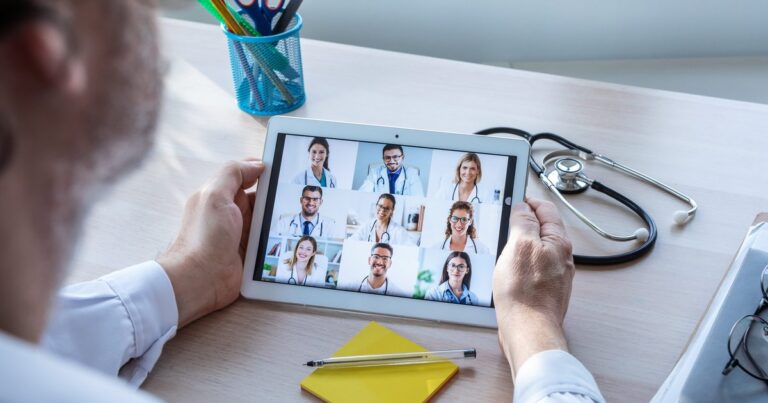Technological advancements are constantly changing the way healthcare providers approach patient care. Among these innovations, the advent of fifth-generation mobile networks (5G) has the potential to redefine how healthcare is delivered.
Global 5G healthcare is estimated to be worth USD 215 million in 2021 and is expected to grow by 76% to reach USD 3,667 million by 2026. Rising adoption of telemedicine and robotic surgery, and increasing use of 5G-enabled wearable medical devices for real-time remote patient monitoring are driving the growth of this market.
Other factors driving growth include the ability of 5G technology to transmit large amounts of patient data quickly, advancements in communication technology, and the availability of low-cost sensors.
5G Unleashes the Power of Telemedicine
At the heart of the 5G revolution is telemedicine, which has boomed during the global pandemic. 5G’s ultra-fast speeds and low latency enable healthcare professionals to conduct virtual consultations with patients in real time, allowing care to be received from virtually anywhere. This is not only convenient, but it also reduces the workload of overburdened healthcare systems.
Remote patient monitoring is also becoming commonplace, with networked wearable devices and medical sensors (all 5G-enabled) allowing continuous, real-time monitoring of patient vital signs and disease progression.
This approach to healthcare management allows for earlier detection of complications, individualized treatment plans, and improved outcomes, especially for patients with chronic diseases.
In Malaysia, for example, the government is exploring digital health solutions for Malaysians.
Minister of Communications Fahmi Fadzil unveiled the CelcomDigi digital healthcare solution, which helps primary care providers such as clinics and pharmacies choose the best connectivity method – mobile or fibre – and incorporate the digital healthcare solution of their choice.
Like many countries, Malaysia has an obesity problem, and chronic diseases such as diabetes and hypertension are becoming increasingly common, meaning there is an urgent need for innovative healthcare solutions to ease the strain on public health services.
Subang Jaya Medical Centre, a private tertiary care hospital in Malaysia, recently launched the country’s first connected health service, called Connected Care. The 400-bed hospital is a joint venture between Ramsay Health Care Australia and Sime Darby Malaysia.
The solution will ultimately be offered across six care areas, the first of which will be telemedicine services for medical enquiries and appointments, as well as remote monitoring services for elderly patients.
“We want to shift from serving patients to serving people, from care delivery to health delivery, and from hospital to home,” said Subang Jaya CEO Brian Lim. “Connected care will transform healthcare delivery, helping patients seamlessly access specialised and affordable healthcare in the comfort of their own home.”
Fast, Reliable 5G for Healthcare
The speed and reliability of 5G are key here, allowing large medical imaging files such as MRI scans and X-rays to be transmitted quickly, enabling medical professionals to make timely and accurate diagnoses, while enabling real-time data sharing and collaboration between multidisciplinary teams to deliver personalized care.
The technology also opens up new possibilities for treatment, such as remote surgery, and examples of its use inside the operating room include harnessing the power of robotics and real-time communication networks.
5G Cost and Time Savings for Healthcare Providers
Cost savings is another factor for 5G: telecommunications company Vodafone UK recently published a study which found that 5G technology could save the UK NHS around £1 billion a year, the equivalent of saving 15,400 full-time nurses.
Vodafone’s modelling takes into account the benefits of remote patient monitoring, freeing up patients and healthcare workers from face-to-face care delivery and freeing up beds for those who need it most.
A Vodafone poll of 500 NHS nurses found that two-thirds (64%) are keen to learn more about digital transformation and are excited about the role technology can play in improving the NHS, while almost half (46%) are optimistic about the potential for technology to transform their day-to-day work.
Nurses have high levels of digital engagement
The survey also found high levels of digital engagement and understanding among nurses, with 71% of nurses saying they have a ‘good’ or ‘very good’ understanding of 5G, compared to 38% of the general public.
Anne-Marie Vine-Lot, director of health at Vodafone UK, said: “Nurses are some of the strongest advocates and adopters of the use of technology in healthcare and are deeply committed to the use of digital technology in the NHS.”
“Like us, they recognise that technologies like 5G will deliver huge benefits to patients and NHS staff, so now is the time to listen to them and take action.”
******
Check out the latest updates Industry News and Insights in Healthcare Digital Also, register for our Global Conference Series. Technology and AI Live 2024
******
Healthcare Digital BizClick brand


